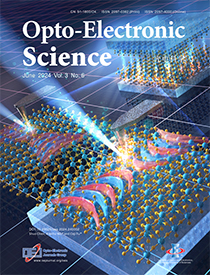2024 Vol. 3, No. 6
Chen S, Wu XH, Fu CJ. Active tuning of anisotropic phonon polaritons in natural van der Waals crystals with negative permittivity substrates and its application in energy transport. Opto-Electron Sci 3, 240002 (2024).
Interactions between light and matter are fundamental to advancements in spectroscopy, sensing, quantum information processing, and laser technologies. Traditionally centered on electron plasma in metals, polariton research has expanded to encompass various material excitations, such as excitons, phonons, and Cooper pairs, which have garnered significant attention in recent years. For nanophotonic applications at infrared frequencies, phonon polaritons (PhPs) have become particularly attractive due to their low optical losses, picosecond-long lifetimes, and inherently anisotropic responses. These properties underscore their potential for applications in subdiffractional focusing, thermal management, in-plane canalization, and hyper-lensing.
The dynamic tunability of phonon polaritons is essential for integrated nanophotonics, necessitating the ability to adjust propagation characteristics and reconfigure dispersion properties. The strong dependence of PhPs on the dielectric environment, combined with the anisotropy of biaxial van der Waals (vdW) crystals such as molybdenum trioxide (α-MoO3), offers novel avenues for manipulating the propagation characteristics of phonon polaritons. Specifically, the iso-frequency contour of PhPs can be reoriented to facilitate propagation along previously forbidden directions when α-MoO3 is placed on a substrate with moderate negative permittivity.
Moreover, the impact of polaritonic coupling on near-field energy transport is contingent on the excitation, reorientation, and annihilation of fundamental modes, which in turn can either enhance or impede photon tunneling. These findings suggest promising new strategies for actively modulating nanoscale heat management through the precise tailoring of phonon polaritons.
This research not only opens up new possibilities for nanoscale thermal management but also provides critical insights into the behavior of in-plane anisotropic polaritons in vdW materials. Consequently, it holds substantial implications for the development of advanced reconfigurable photonic devices and enhanced thermal conductivity control at the nanoscale.

-
{{article.year}}, {{article.volume}}({{article.issue}}): {{article.fpage | processPage:article.lpage:6}}. doi: {{article.doi}}{{article.articleStateNameEn}}, Published online {{article.preferredDate | date:'dd MMMM yyyy'}}, doi: {{article.doi}}{{article.articleStateNameEn}}, Accepted Date {{article.acceptedDate | date:'dd MMMM yyyy'}}CSTR: {{article.cstr}}
-
{{article.year}}, {{article.volume}}({{article.issue}}): {{article.fpage | processPage:article.lpage:6}}. doi: {{article.doi}}{{article.articleStateNameEn}}, Published online {{article.preferredDate | date:'dd MMMM yyyy'}}, doi: {{article.doi}}{{article.articleStateNameEn}}, Accepted Date {{article.acceptedDate | date:'dd MMMM yyyy'}}CSTR: {{article.cstr}}

 E-mail Alert
E-mail Alert RSS
RSS


